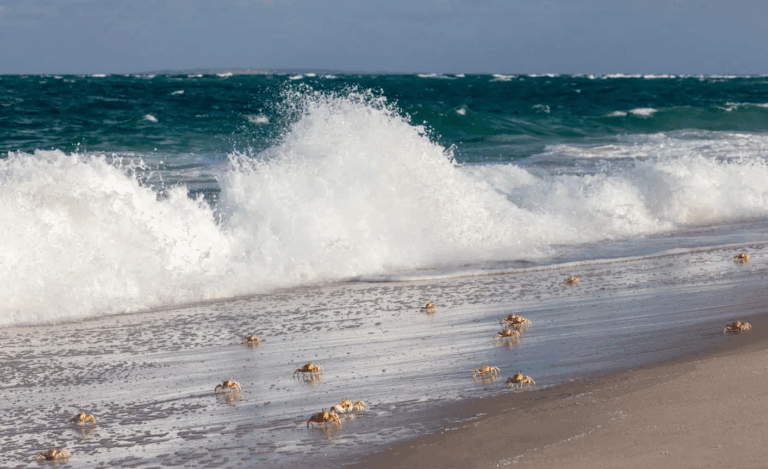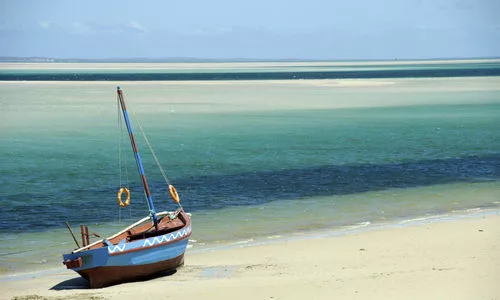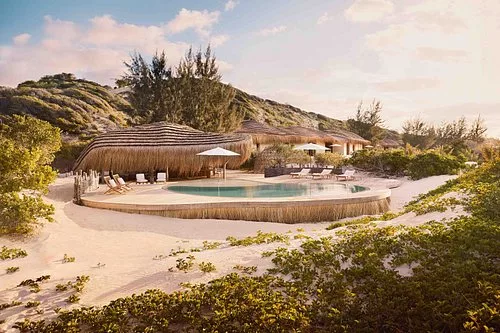Kisawa Sanctuary on Benguerra Island, just off the coast of Southern Mozambique, blends wild beauty with quiet elegance. Set between dunes, forest, and the Indian Ocean, this eco-resort offers more than beachside bliss — it’s a model for how luxury travel can protect what it celebrates.
This resort isn’t just a place to relax; it’s a place to regenerate — for the planet, for local communities, and travellers seeking deeper meaning in their journeys.
Built to blend in, not take over
Picture/Mozambique Travel
From its very foundations, Kisawa was designed to tread lightly. Using pioneering 3D-printing technology that combines sand and seawater mortar, the resort minimised environmental disruption during construction. Not a single tree was cut down, and each structure feels embedded in nature rather than imposed upon it.
The sanctuary’s 12 expansive bungalows — each with its own beachfront, infinity pool and dedicated service team — are spread across a 300-hectare stretch of coast and forest. Electric buggies replace petrol vehicles, solar panels power the estate, and there’s a strict no-single-use-plastic policy.
Conservation at its core

Picture/@BCSS & Orlando, Miranda+Salvador Colvee
More than a resort, Kisawa funds real-time ocean conservation through its sister organisation, the Bazaruto Centre for Scientific Studies (BCSS). This non-profit marine observatory shares the island with the resort and is one of Africa’s first permanent ocean observatories.
Here, marine biologists tag manta rays, monitor coral reef health, and track the migratory patterns of endangered species. As a guest, you’re not just a bystander — your stay directly supports this scientific work. Guests can visit the research centre, engage with the scientists, and even join data-gathering expeditions – It’s luxury travel with measurable impact.
ALSO READ: Georgia: A fusion of Europe and Asia
Cultural integrity and local empowerment

Picture/Mozambique Travel
Kisawa is deeply rooted in Mozambique’s cultural fabric. From the use of traditional thatching methods to the carved furniture and handwoven textiles that furnish each bungalow, the sanctuary honours local craftsmanship.
The team is primarily composed of Mozambican staff, trained in hospitality, culinary arts, and wellness therapies. Guests can explore local flavours in the resort’s open-air restaurants or learn to cook matapa (a traditional Mozambican dish) during immersive cooking sessions.
Beyond aesthetics, this commitment helps preserve cultural heritage and uplifts local communities, creating a luxury experience that feels grounded and meaningful.
When to go

Picture/Bazaruto Archipelago/Original Diving
Mozambique’s Bazaruto Archipelago enjoys a tropical climate year-round, but the best time to visit Kisawa is during the dry season is between July and October. Days are warm and sunny with little rainfall — perfect for snorkelling, diving, and beach lounging.
June to August is peak for whale watching, as humpbacks migrate along the coast. November to February brings hotter, more humid weather with occasional rain, but it’s also turtle nesting season — a rare and moving sight for nature lovers.
Avoid the cyclone-prone months of late January to early March if you’re seeking uninterrupted beach time.
Who is it for?

Picture/Tripadvisor
Kisawa Sanctuary appeals to travellers who want their trips to matter. Whether you’re a honeymooner seeking barefoot privacy, a wellness traveller craving serenity, or a conscious explorer eager to support ocean conservation, this sanctuary caters to those who believe in luxury with purpose.
Families are welcome too, though the tone is quiet and tailored more to restorative stays than rambunctious beach holidays.
For those disillusioned by cookie-cutter resorts, Kisawa offers something singular: the feeling that you’ve arrived at the edge of the world — and that your presence is helping preserve it.
Follow us on social media for more travel news, inspiration, and guides. You can also tag us to be featured.
TikTok | Instagram | Facebook | Twitter
ALSO READ: The best places to visit in the Algarve

